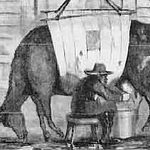Whether served fried, steamed, or boiled, dumplings can tell the story of a geography by how it's cooked and eaten. As We Eat concludes its three-part series exploring the global cuisine of dumplings with our third installment examining the twin stories of the “dumpling” darling of a classic American comfort food. Are you Team Fluffy or Team Slick?
An All-American Classic
As we’ve discovered in our three-part series, dumplings reign as a perpetual favorite in cuisines all over the world, and North America is no different. Here in the States, two different formulations of dumplings form the backbone to an All-American classic dish: Chicken & Dumplings. In many ways, the popularity of that dish is no real mystery - people have been enjoying meat stewed with vegetables for centuries - but it definitely gains an advantage from a fluffy soft or slick chewy dumplings.
The Great Dumpling Divergence
Before starting our dumpling showdown, Kim and Leigh discuss the disputed origins of Chicken & Dumplings, a dish often mistakenly thought to have originated in the 20th Century as a thrifty but nutritious answer to food scarcity during the Great Depression or the First World War.
Representing “Team Fluffy,” Leigh tours us through some later 19th Century cookbooks describing assorted methods to create the dish either by dropping biscuit dough directly onto boiling stew to create a cloud-like doughy biscuit “dumpling.” These treats are not unlike the British “floaters” discussed in our second Dumpling exploration (Episode 49) and are more commonly found in cookbooks and recipe collections originating from the American North.
Representing “Team Slick,” Kim talks about how recipes calling for biscuit dough rolled thin, cut, and boiled separately from the main chicken stew tend to originate south of the Mason-Dixon line, and maybe not much more than a stubborn retort to their Northern rivals. The version of Chicken & Dumpling that Kim fondly remembers is broadly known in Amish and Pennsylvania Dutch cuisine as “Bott Boi” or chicken pot pie - yet nothing like the crusted version we commonly know.
We wrap up by touching on another Pennsylvania cultural staple - fruit dumplings. This version however more closely resembles a boiled pudding than the baked cherry or apple treats that we might imagine. Even so, its popularity has made it the focus of the summertime Apple Dumpling Festival and Pageant in Sinking Spring, PA.
Are you Team Fluffy or Team Slick?
Episode Transcript
🎧 Click here for the full, interactive transcript of this episode 🎧
Sources We Found Helpful for this Episode
Books We Think You’ll Enjoy Reading
The Virginia Housewife by Mary Randolph
The Kentucky Housewife by Lettice Brian
Carolina Housewife by Sarah Rutledge
Housekeeping in Old Virginia by Marion Kabel Tyre
Recipes You Really Need to Try
Pennsylvania Dutch Chicken Pot Pie from a Coal Cracker in the Kitchen
Southern Chicken and Dumplings from Pastry Chef Online
Nothing says comfort like homemade chicken and dumplings - Chesterfield Observer
Chicken Soup with Butter Dumplings from Chez Us
Episodes We Think You’ll Like
EP 2 Pie: Crazy Labels, Cockney Rhyming Slang, and Greek Melons
EP 48 Dumplings Around the World: Pan Asian Dumplings from Chinese Medicine to Dim Sum
EP 49 Dumplings Around the World: European Dumplings from Saints to Holy Justice in Just One Bite
Join us in two weeks for episode 51 when we discuss rice. If you’re enjoying the podcast, we would love to have you join our supporting subscribers. For just a few dollars, you can get access to exclusive content, including the Recipe Box Roulette “card game”, more in-depth articles, and recipes. You’ll also help keep our oven lights on!
We would love to connect with you
AsWeEat.com, on Instagram @asweeat, join our new As We Eat community on Facebook, or subscribe to the As We Eat Journal.
Do you have a great idea 💡 for a show topic, a recipe 🥘 that you want to share, or just say “hi”👋🏻? Send us an email at connect@asweeat.com
Review As We Eat on Podchaser or Apple Podcast. We would like to know what you think.
Thank you for listening to the As We Eat Podcast. This post is public so share it with a friend - or three :)
























Share this post